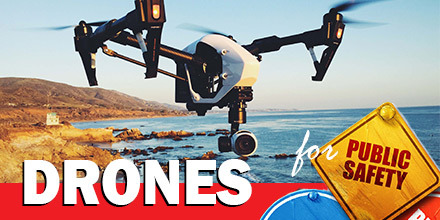Keys to Adding Drones to Public Safety Agency Operations
 Often, one of the biggest obstacles to the widespread adoption of any new technology is the initial uncertainty of the regulation landscape.
Often, one of the biggest obstacles to the widespread adoption of any new technology is the initial uncertainty of the regulation landscape.
For example, consider the promise of self-driving cars. While the technology is advancing by leaps and bounds, the much-needed test-driving hours are constrained by red tape. Without real-world testing the acceptance and adoption of this technology stalls.
Thankfully, drones are further down the road in terms of both societal acceptance and utilization. As the regulation landscape settles, the largest growth of drones is still ahead.
Today, more and more industries utilize drones to perform functions that were once unimaginable. Public Safety Agencies are beginning to harness their potential, as well. And, though they are some integration obstacles, advanced planning can reduce the pain.
Challenges of adding drones
For most public agencies, navigating drone operation regulations is fairly straightforward and manageable. A thornier issue is managing public opinion.
Public opposition to the use of UAVs by local municipalities, though decreasing, is still fairly high. A new Rasmussen Reports national telephone and online survey finds that 36% of American Adults now favor the use of unmanned drones by police agencies in the United States. Slightly more (39%) still oppose the use of police drones, while 25% are undecided.
Objections range from concerns about privacy to liability issues in the event of a drone mishap.
At the same time, municipal agencies face resistance from within their organizations. Of particular concern is the financial cost of purchasing equipment, training staff, and the natural hesitance that comes with adopting any new technology.
It’s best if any agency looking to add drones to the public safety toolkit address these issues in advance.
Overcoming Perceptions
Drones are powerful tools which can help maintain public safety, assist in search and rescue operations and even perform humanitarian relief work.
However, for many in the general public, drones are just glorified toys. In part, this is due to the relative newness of the technology coupled with limited experience with “serious” drone operations.
The “drone is just a toy” mentality is particularly harmful when it comes to price. Acquiring a drone built for commercial or public service involves considerable financial outlay.
Commercial drones can cost several thousand dollars once peripherals and accessories are taken into consideration. There is also the added cost of training personnel and securing the proper certification for the pilots.
Understanding the costs of adding a drone to the agency is imperative. Keep in mind, though, the technological benefits are substantial.
From conducting night operations with infrared cameras to surveying areas that are inaccessible or inhospitable to humans, drones extend the reach of an agency. In high risk situations, drones can help minimize personnel exposure. Plus, drones are highly portable with a small take-off and landing footprint, and deploy rapidly.
Integrating the technology
Once an agency decides to add a drone to their operations, the next step is to ensure adequate preparation for their use.
Commercial drone operations are, of course, regulated by the Federal Aviation Administration (FAA). Drone operators must complete training and certification before taking control of a drone. The agency, as well, must apply for their waiver in order to conduct operations.
The issue of liability is another consideration when integrating this technology.
In the course of any operation, mishaps occur. It is important to understand the liabilities associated with operating a drone for public safety work. It is helpful, too, to understand how they agency will handle any liability issues that arise. A review of insurance coverage is vital.
Integrating drone technology into public safety operations can vastly improve the reach and efficiency of an agency. With careful investment in the right equipment, training and education, an agency can integrate drones with much success.

